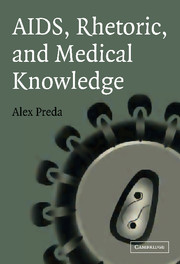Book contents
- Frontmatter
- Contents
- Acknowledgments
- List of Abbreviations
- Introduction
- 1 Making Up the Rules of Seeing
- 2 The Economy of Risk Categories
- 3 The Etiologic Agent and the Rhetoric of Scientific Debate
- 4 Retrovirus vs. Retrovirus
- 5 The Spatial Configurations of “AIDS Risk”
- 6 Who Is How Much?
- 7 In Lieu of a Conclusion
- References
- Index
- References
References
Published online by Cambridge University Press: 25 July 2009
- Frontmatter
- Contents
- Acknowledgments
- List of Abbreviations
- Introduction
- 1 Making Up the Rules of Seeing
- 2 The Economy of Risk Categories
- 3 The Etiologic Agent and the Rhetoric of Scientific Debate
- 4 Retrovirus vs. Retrovirus
- 5 The Spatial Configurations of “AIDS Risk”
- 6 Who Is How Much?
- 7 In Lieu of a Conclusion
- References
- Index
- References
- Type
- Chapter
- Information
- AIDS, Rhetoric, and Medical Knowledge , pp. 249 - 268Publisher: Cambridge University PressPrint publication year: 2004



